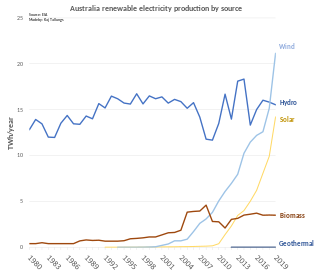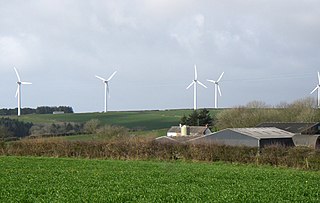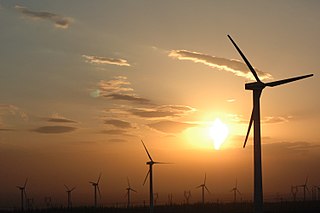Related Research Articles

Grid energy storage is a collection of methods used for energy storage on a large scale within an electrical power grid. Electrical energy is stored during times when electricity is plentiful and inexpensive or when demand is low, and later returned to the grid when demand is high, and electricity prices tend to be higher.

The United Kingdom is the best location for wind power in Europe and one of the best in the world. By 2023, the UK had over 11 thousand wind turbines with a total installed capacity of 28 gigawatts (GW): 14 GW onshore and 14 GW offshore, the sixth largest capacity of any country. Wind power generated about 25% of UK electricity, having surpassed coal in 2016 and nuclear in 2018. It is the largest source of renewable electricity in the UK.

Hybrid power are combinations between different technologies to produce power.

Solar power is a fast-growing industry in Australia. As of June 2023, Australia's over 3.52 million solar PV installations had a combined capacity of 32,095 MW photovoltaic (PV) solar power, of which at least 4,389 MW were installed in the preceding 12 months. In 2019, 59 solar PV projects with a combined capacity of 2,881 MW were either under construction, constructed or due to start construction having reached financial closure. Solar accounted for 12.4% of Australia's total electrical energy production in 2021.

The production of renewable energy in Scotland is a topic that came to the fore in technical, economic, and political terms during the opening years of the 21st century. The natural resource base for renewable energy is high by European, and even global standards, with the most important potential sources being wind, wave, and tide. Renewables generate almost all of Scotland's electricity, mostly from the country's wind power.

Spain is one of the first countries to deploy large-scale solar photovoltaics, and is the world leader in concentrated solar power (CSP) production.

Renewable energy in Australia includes wind power, hydroelectricity, solar photovoltaics, heat pumps, geothermal, wave and solar thermal energy.
Wind power has a history in Canada dating back many decades, particularly on prairie farms. As of December 2021, wind power generating capacity was approximately 14,304 megawatts (MW). Combined with 2,399 MW of solar power generating capacity, this provided about 6.5% of Canada's electricity demand as of 2020. The Canadian Wind Energy Association (CanWEA) has outlined a future strategy for wind energy that would reach a capacity of 55 GW by 2025, meeting 20% of the country's energy needs.

Renewable energy in the United Kingdom contributes to production for electricity, heat, and transport.

Wind power generates about 10% of Turkey's electricity, mainly in the west in the Aegean and Marmara regions, and is gradually becoming a larger share of renewable energy in the country. As of 2023, Turkey has 11 gigawatts (GW) of wind turbines. The Energy Ministry plans to have almost 30 GW by 2035.

China is the world's leader in electricity production from renewable energy sources, with over triple the generation of the second-ranking country, the United States. China's renewable energy sector is growing faster than its fossil fuels and nuclear power capacity, and is expected to contribute 43 per cent of global renewable capacity growth. China's total renewable energy capacity exceeded 1,000 GW in 2021, accounting for 43.5 per cent of the country's total power generation capacity, 10.2 percentage points higher than in 2015. The country aims to have 80 per cent of its total energy mix come from non-fossil fuel sources by 2060, and achieve a combined 1,200 GW of solar and wind capacity by 2030. In 2023, it was reported that China was on track to reach 1,371 gigawatts of wind and solar by 2025, five years ahead of target due to new renewables installations breaking records.

China is the world leader in wind power generation, with the largest installed capacity of any nation and continued rapid growth in new wind facilities. With its large land mass and long coastline, China has exceptional wind power resources: it is estimated China has about 2,380 gigawatts (GW) of exploitable capacity on land and 200GW on the sea. Wind power remained China's third-largest source of electricity at the end of 2021, accounting for 7.5% of total power generation.

As of 2019, renewable energy in Morocco covered 35% of the country’s electricity needs.
In 2016, Arizona had 268 megawatts (MW) of wind powered electricity generating capacity, producing 0.5% of in-state generated electricity.

Enel Green Power S.p.A. is an Italian multinational renewable energy corporation, headquartered in Rome. The company was formed as a subsidiary of the power generation firm Enel in December 2008. It has operations in five continents generating energy from solar, geothermal, wind and hydropower sources. As of 2022, it manages a capacity of 59,9 GW and has over 1200 plants worldwide.

Renewables supply a quarter of energy in Turkey, including heat and electricity. Some houses have rooftop solar water heating, and hot water from underground warms many spas and greenhouses. In parts of the west hot rocks are shallow enough to generate electricity as well as heat. Wind turbines, also mainly near western cities and industry, generate a tenth of Turkey’s electricity. Hydropower, mostly from dams in the east, is the only modern renewable energy which is fully exploited. Hydropower averages about a fifth of the country's electricity, but much less in drought years. Apart from wind and hydro, other renewables; such as geothermal, solar and biogas; together generated almost a tenth of Turkey’s electricity in 2022. Furthermore, Türkiye has ranked 5th in Europe and 12th in the world in terms of installed capacity in renewable energy. The share of renewables in Türkiye’s installed power reached to 54% at the end of 2022.
The Port Augusta Renewable Energy Park is a combined wind and solar farm under construction south of Port Augusta in South Australia, Australia. The solar farm is planned to be at the northern end of the site, west of the Augusta Highway and south of Sundrop Farms. The wind turbines will be on both sides of the Augusta Highway, extending south as far as the road to Horrocks Pass. Construction formally started in October 2020 and is estimated to take about 18 months to complete. The total site is about 5,400 hectares.
Green hydrogen (GH2 or GH2) is hydrogen produced by the electrolysis of water, using renewable electricity. Green hydrogen has significantly lower greenhouse gas emissions than grey hydrogen, which is derived from fossil fuels without carbon capture. Green hydrogen may be used to decarbonize sectors that are hard to electrify, such as cement and steel production. Green hydrogen can be used to produce green ammonia, the main constituent of synthetic fertilizer. It can also be used for long-duration grid energy storage, and for long-duration seasonal energy storage.
References
- ↑ Singh, Ruchira (15 June 2022). "UK's BP to acquire 40.5% stake in Australia's 26 GW Asian Renewable Energy Hub". www.spglobal.com.
- 1 2 3 4 5 6 7 Collins, Ben (10 November 2020). "World's largest renewable energy project proposed for north-west Australia ditches electricity in favour of ammonia exports". ABC News (Australian Broadcasting Corporation). Retrieved 12 November 2020.
- 1 2 Beattie, Shannon (2 November 2020). "Clean energy for the future". Farm Weekly . Retrieved 12 November 2020.
- ↑ Morton, Adam (21 June 2021). "Environment minister rules huge renewable energy hub in WA 'clearly unacceptable'". The Guardian . Retrieved 16 July 2021.
- 1 2 3 "Massive Asian Renewable Energy Hub grows to 26GW of wind and solar". RenewEconomy. 16 October 2020. Retrieved 12 November 2020.
- ↑ Fowler, Elouise (22 October 2020). "Renewable energy hub to get 'major project' status". Australian Financial Review . Retrieved 12 November 2020.
- ↑ "WA land allocation advances plans for 26 GW renewable energy hub". pv magazine Australia. 9 January 2023. Retrieved 11 August 2023.